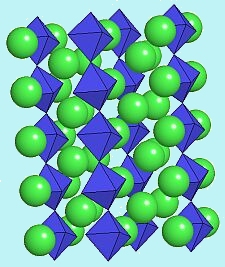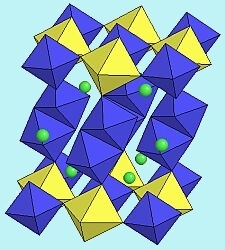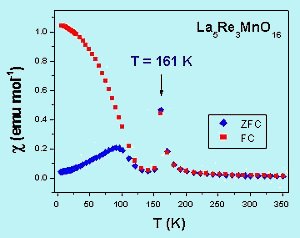
Research Interests
I. METAL-INSULATOR TRANSITIONS
II. GEOMETRICALLY FRUSTRATED MAGNETIC MATERIALS
III. SEARCH FOR NEW MATERIALS
|

|
|
Research Interests
|

|
New Materials
|
 topic of recent interest in the group concerns complex oxides which contain the 4d and 5d transition elements and their electronic properties (magnetism and electrical transport). While the crystal chemistry and properties of materials based on the 3d transition metals have been studied intensively over the past decades, 4d- and 5d-based compounds represent a much less explored area in transition metal chemistry, but one which is potentially vast and which is becoming increasingly important. One expects very different crystal chemistry and structure-property correlations in the 4d and 5d groups vis-a-vis the 3d group due to several factors, including the more extended nature of the 4d and 5d orbitals, the predominance of higher oxidation states and the tendency to form metal-metal bonded clusters. Recent examples from our group include the quasi-one-dimensional R3MO7 compounds (R = rare earth element; M = Ru, Re and Os), illustrated by Pr3RuO7 (Figure 1), where the isolated chains of corner-sharing RuO6 octahedra are emphasized. topic of recent interest in the group concerns complex oxides which contain the 4d and 5d transition elements and their electronic properties (magnetism and electrical transport). While the crystal chemistry and properties of materials based on the 3d transition metals have been studied intensively over the past decades, 4d- and 5d-based compounds represent a much less explored area in transition metal chemistry, but one which is potentially vast and which is becoming increasingly important. One expects very different crystal chemistry and structure-property correlations in the 4d and 5d groups vis-a-vis the 3d group due to several factors, including the more extended nature of the 4d and 5d orbitals, the predominance of higher oxidation states and the tendency to form metal-metal bonded clusters. Recent examples from our group include the quasi-one-dimensional R3MO7 compounds (R = rare earth element; M = Ru, Re and Os), illustrated by Pr3RuO7 (Figure 1), where the isolated chains of corner-sharing RuO6 octahedra are emphasized.
|

|
 |
Another example is provided by the newly discovered "pillared" perovskites of general composition R5[M2O10][M′ M″O6]. The structure of this latter phase is illustrated by La5Re3MnO16, (La5[Re2O10][ReMnO6]) (Figure 2), where layers of ReVMnIIO6 units, consisting of corner-sharing octahedra (the definitive structural motif of perovskites) which are separated or "pillared" by ReV2O10 dimeric units in which a Re=Re double bond is present. An exploration of the crystal chemistry of this new structure type is currently underway in which substitutions are being attempted in both the layer and dimer sites.
The magnetic properties of these new materials are very surprising as exemplified by La5[Re2O10] (Figure 3). We have shown just recently, using neutron diffraction, that the sharp spike at ~ 160 K is due to a complex type of magnetic order involving the weak coupling of the [ReMnO6] layers through the diamagnetic [Re2O10] dimers. That the transition occurs at such a relatively high temperature, ~ 160 K, is surprising given that the interlayer separation is > 10 Å and this phenomenon is being explored in greater detail.
|
| Fig-1 structure of Pr3RuO7 |
|
|
|
|
top of page
|
HOME | NEWS | RESEARCH | GROUP | FACILITIES | PUBLICATIONS | J. E. GREEDAN
© 2009 J.E. Greedan / McMaster University
All Rights Reserved
Last updated:
|
|






